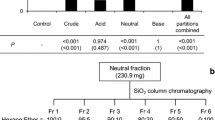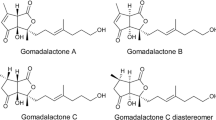Abstract
Callosobruchus analis (Coleoptera: Chrysomelidae: Bruchinae), found throughout tropical Asia and Africa, is a pest of stored legumes. Previous work has shown that females of this species produce a contact sex pheromone that elicits copulatory behavior in males. Comparisons of copulatory activity between any two of four congeneric species suggest that the contact sex pheromones are species specific. In laboratory bioassays, male C. analis exhibited copulatory behavior to a female dummy to which a crude extract of virgin females was applied. The extract had been collected by a filter paper method and was purified by acid–base partition and chromatographic techniques. Gas chromatography-mass spectrometry (GC-MS) analyses of active fractions revealed that the active compounds were 2,6-dimethyloctane-1,8-dioic acid (1) and callosobruchusic acid, (E)-3,7-dimethyl-2-octene-1,8-dioic acid (2), previously identified as contact sex pheromones of Callosobruchus maculatus (F.) and C. chinensis (L.), respectively. The stereoisomeric and chemical compositions were determined by the 2D-HPLC-Ohrui-Akasaka method as (2S,6R)-1:(S)-2 = 1.8:1, which meant that both compounds in C. analis were stereochemically pure, unlike the case of C. maculatus and C. chinensis. An examination of the influence of synthetic pheromone compounds on male copulatory activity revealed that (2S,6R)-1 is the main component, and that (S)-2 has an additive effect. In the examination of the stereochemistry-activity relationship, no copulatory behavior was elicited by (2R,6S)-1, and, furthermore, the enantiomer significantly masked the pheromonal activity of (2S,6R)-1. Glass rod dummy assays also suggested the presence of synergists. These results could elucidate the specificity of mate recognition in C. analis.






Similar content being viewed by others
References
ABO, M., and MORI, K. 1993. Synthesis of (R)-callosobruchusic acid from methyl (R)-3-carboxybutanoate. Biosci. Biotechnol. Biochem. 57:265–267.
AKASAKA, K., and OHRUI, H. 1999. Enantiomeric separation of branched fatty acids after conversion with trans-2-(2,3-anthracenedicarboximido)cyclohexanol, a highly sensitive chiral fluorescent conversion reagent. Biosci. Biotechnol. Biochem. 63:1209–1215.
AKASAKA, K., MEGURO, H., and OHRUI, H. 1997. Enantiomeric separation of carboxylic acids having chiral centers remote from the carboxyl group by labelling with a chiral fluorescent derivatization reagent. Tetrahedron Lett. 38:6853–6856.
AKASAKA, K., IMAIZUMI, K., and OHRUI, H. 1998. Enantiomeric separation of branched fatty acids having chiral centers remote from the carboxyl group by labeling with chiral fluorescent derivatization reagents. Enantiomer 3:169–174.
BIRCH, M. C. 1974. Aphrodisiac pheromones in insects, pp. 115–134, in M. C. Birch (ed.). Pheromones. North-Holland, Amsterdam.
BOSTEDOR, R. G., KARKAS, J. D., ARISON, B. H., BANSAL, V. S., VAIDYA, S., GERMERSHAUSEN, J. I., KURTZ, M. M., and BERGSTROM, J. D. 1997. Farnesol-derived dicarboxylic acids in the urine of animals treated with zaragozic acid A or with farnesol. J. Biol. Chem. 272:9197–9203.
CORK, A., HALL, D. R., BLANEY, W. M., and SIMMONDS, M. S. J. 1991. Identification of a component of the female sex pheromone of Callosobruchus analis (Coleoptera: Bruchidae). Tetrahedron Lett. 32:129–132.
DESS, D. B., and MARTIN, J. C. 1983. Readily accessible 12-I-5 oxidant for the conversion of primary and secondary alcohols to aldehydes and ketones. J. Org. Chem. 48:4155–4156.
ELIYAHU, D., MORI, K., TAKIKAWA, H., LEAL, W. S., and SCHAL, C. 2004. Behavioral activity of stereoisomers and a new component of the contact sex pheromone of female German cockroach, Blattella germanica. J. Chem. Ecol. 30:1839–1848.
EVANS, D. A., and WEBER, A. E. 1987. Synthesis of the cyclic hexapeptide echinocandin D. New approaches to the asymmetric synthesis of β-hydroxy α-amino acids. J. Am. Chem. Soc. 109:7151–7157.
EVANS, D. A., ENNIS, M. D., and MATHRE, D. J. 1982. Asymmetric alkylation reactions of chiral imide enolates. A practical approach to the enantioselective synthesis of α-substituted carboxylic acid derivatives. J. Am. Chem. Soc. 104:1737–1739.
FUKAYA, M., and HONDA, H. 1992. Reproductive biology of the yellow-spotted longicorn beetle, Psacothea hilaris (PASCOE) (Coleoptera: Cerambycidae) I. male mating behaviors and female sex pheromones. Appl. Entomol. Zool. 27:89–97.
GEMENO, C., and SCHAL, C. 2004. Sex pheromones of cockroaches, pp. 179–247, in R. T. Cardé and J. G. Millar (eds.). Advances in Insect Chemical Ecology. Cambridge University Press, Cambridge.
GIERSCH, W., and SCHULTE-ELTE, K. H. 1990. Enantiomeric 3,7-dimethylocta-1,7-dienes as useful chiral building blocks. A new access to both optical antipodes of natural (E)-3,7-dimethyloct-2-ene-1,8-diol and (E)-3,7-dimethyloct-2-ene-1,8-dicarboxylic acid. Helv. Chim. Acta 73:733–738.
GRAMATICA, P., GIARDINA, G., SPERANZA, G., and MANITTO, P. 1985. Bakers’ yeast hydrogenation of carbonyl activated double bonds. Enantioselective synthesis of the (S)-form of the dihydroterpenediol secreted by Danaus chrysippus and of a pheromone of Callosobruchus chinensis L. Chem. Lett. 14:1395–1398.
GRÖNING, J., and HOCHKIRCH, A. 2008. Reproductive interference between animal species. Q. Rev. Biol. 83:257–282.
HAINES, C. P. 1989. Observations on Callosobruchus analis (F.) in Indonesia, including a key to storage Callosobruchus spp (Col., Bruchidae). J. Stored Prod. Res. 25:9–16.
IMAMURA, Y., TAKIKAWA, H., SASAKI, M., and MORI, K. 2004. Triterpenoid total synthesis. Synthesis and absolute configuration of mispyric acid. Org. Biomol. Chem. 2:2236–2244.
JOHANSSON, B. G., and JONES, T. M. 2007. The role of chemical communication in mate choice. Biol. Rev. 82:265–289.
MILLAR, J. G. 2000. Polyene hydrocarbons and epoxides: a second major class of Lepidopteran sex attractant pheromones. Annu. Rev. Entomol. 45:575–604.
MORI, K. 2007. Significance of chirality in pheromone science. Bioorg. Med. Chem. 15:7505–7523.
MORI, K., MASUDA, S., and SUGURO, T. 1981. Stereocontrolled synthesis of all of the possible stereoisomers of 3,11-dimethylnonacosan-2-one and 29-hydroxy-3,11-dimethylnonacosan-2-one: The female sex pheromone of the German cockroach. Tetrahedron 37:1329–1340.
MORI, K., ITO, T., TANAKA, K., HONDA, H., and YAMAMOTO, I. 1983. Synthesis and biological activity of optically active forms of (E)-3,7-dimethyl-2-octene-1,8-dioic acid (callosobruchusic acid): a component of the copulation release pheromone (erectin) of the azuki bean weevil. Tetrahedron 39:2303–2306.
NAKAI, T., YAJIMA, A., AKASAKA, K., KAIHOKU, T., OHTAKI, M., NUKADA, T., OHRUI, H., and YABUTA, G. 2005. Synthesis of the four stereoisomers of 2,6-dimethyloctane-1,8-dioic acid, a component of the copulation release pheromone of the cowpea weevil, Callosobruchus maculatus. Biosci. Biotechnol. Biochem. 69:2401–2408.
NANDA, S., and SCOTT, A. I. 2004. Asymmetric synthesis of (E)- and (Z)-3,7-dimethyl-2-octene-1,8-diol and callosobruchusic acid. Tetrahedron Asymm. 15:963–970.
NEMOTO, H., SATOH, A., FUKUMOTO, K., and KABUTO, C. 1995. A rapid access to both enantiomers of 1,2,3,4-tetranor B-trienic 18,18,18-trifluorosteroids. The first enantiocontrolled total synthesis of 18,18,18-trifluorosteroids. J. Org. Chem. 60:594–600.
NISHIDA, R., and FUKAMI, H. 1983. Female sex pheromone of the German cockroach, Blattella germanica. Mem. Coll. Agric., Kyoto Univ. 122:1–24.
NOJIMA, S., SHIMOMURA, K., HONDA, H., YAMAMOTO, I., and OHSAWA, K. 2007. Contact sex pheromone components of the cowpea weevil, Callosobruchus maculatus. J. Chem. Ecol. 33:923–933.
REES, D. P. 1996. Coleoptera, pp. 1–40, in B. Subramanyam and D. W. Hagstrum (eds.). Integrated Management of Insects in Stored Products. Marcel Dekker, New York.
REES, D. 2004. Beetles (Order: Coleoptera), pp. 11–120, in D. Rees (ed.). Insects of Stored Products. CSIRO, Canberra.
RICE, W. R. 1989. Analyzing tables of statistical tests. Evolution. 43:223–225.
RITCHIE, M. G. 2007. Sexual selection and speciation. Annu. Rev. Ecol. Evol. Systemat. 38:79–102.
RUNDLE, H. D., CHENOWETH, S. F., DOUGHTY, P., and BLOWS, M. W. 2005. Divergent selection and the evolution of signal traits and mating preferences. PLoS Biol. 3:1988–1995.
SHIMOMURA, K., MIMURA, T., ISHIKAWA, S., YAJIMA, S., and OHSAWA, K. 2010. Variation in mate recognition specificities among four Callosobruchus seed beetles. Entomol. Exp. Appl. 135:315–322.
SINGER, F. 1990. Reproductive costs arising from incomplete habitat segregation among three species of Leucorrhinia dragonflies. Behaviour 115:188–202.
SUGENO, W., HORI, M., and MATSUDA, K. 2006. Identification of the contact sex pheromone of Gastrophysa atrocyanea (Coleoptera: Chrysomelidae). Appl. Entomol. Zool. 41:269–276.
TANAKA, K., OHSAWA, K., HONDA, H., and YAMAMOTO, I. 1981. Copulation release pheromone, erectin, from the azuki bean weevil (Callosobruchus chinensis L.). J. Pestic. Sci. 6:75–82.
TANAKA, K., OHSAWA, K., HONDA, H., and YAMAMOTO, I. 1982. Synthesis of erectin, a copulation release pheromone of the azuki bean weevil, Callosobruchus chinensis L. J. Pestic. Sci. 7:535–537.
TUDA, M., CHOU, L.-Y., NIYOMDHAM, C., BURANAPANICHPAN, S., and TATEISHI, Y. 2005. Ecological factors associated with pest status in Callosobruchus (Coleoptera: Bruchidae): high host specificity of non-pests to Cajaninae (Fabaceae). J. Stored Prod. Res. 41:31–45.
YAJIMA, A., AKASAKA, K., NAKAI, T., MAEHARA, H., NUKADA, T., OHRUI, H., and YABUTA, G. 2006. Direct determination of the stereoisomer constitution by 2D-HPLC and stereochemistry-pheromone activity relationship of the copulation release pheromone of the cowpea weevil, Callosobruchus maculatus. Tetrahedron 62:4590–4596.
YAJIMA, A., AKASAKA, K., YAMAMOTO, M., OHMORI, S., NUKADA, T., and YABUTA, G. 2007a. Direct determination of the stereoisomeric composition of callosobruchusic acid, the copulation release pheromone of the azuki bean weevil, Callosobruchus chinensis L., by the 2D-Ohrui-Akasaka method. J. Chem. Ecol. 33:1328–1335.
YAJIMA, A., YAMAMOTO, M., NUKADA, T., and YABUTA, G. 2007b. Efficient and stereo-selective syntheses of three stereoisomers of the sex pheromone of the cowpea weevil, Callosobruchus maculatus. Biosci. Biotechnol. Biochem. 71:2720–2724.
YAJIMA, A., QIN, Y., ZHOU, X., KAWANISHI, N., XIAO, X., WANG, J., ZHANG, D., WU, Y., NUKADA, T., YABUTA, G., QI, J., ASANO, T., and SAKAGAMI, Y. 2008. Synthesis and absolute configuration of hormone α1. Nat. Chem. Biol. 4:235–237.
YU, G., HUANG, J., HOU, J., LI, Y., and XU, Z. 2002. Synthesis of (R)(E)-3,7-dimethyl-2-octene-1,8-dioic acid, a copulation released pheromone component of azuki bean weevil. Chem. Res. Chin. Univ. 18:397–399.
ZHANG, A., OLIVER, J. E., CHAUHAN, K., ZHAO, B., XIA, L., and XU, Z. 2003. Evidence for contact sex recognition pheromone of the Asian longhorned beetle, Anoplophora glabripennis (Coleoptera: Cerambycidae). Naturwissenschaften 90:410–413.
Acknowledgments
We thank Dr. Yukihiko Toquenaga (University of Tsukuba) for providing C. analis. We are also thankful to Associate Editor Steven J. Seybold for his help on previous drafts of this manuscript.
Author information
Authors and Affiliations
Corresponding author
Rights and permissions
About this article
Cite this article
Shimomura, K., Akasaka, K., Yajima, A. et al. Contact Sex Pheromone Components of the Seed Beetle, Callosobruchus analis (F.). J Chem Ecol 36, 955–965 (2010). https://doi.org/10.1007/s10886-010-9841-z
Received:
Revised:
Accepted:
Published:
Issue Date:
DOI: https://doi.org/10.1007/s10886-010-9841-z




